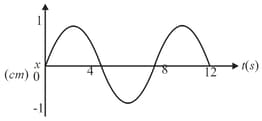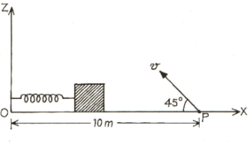B M Sharma Solutions for Chapter: Linear and Angular Simple Harmonic Motion, Exercise 4: Archives
B M Sharma Physics Solutions for Exercise - B M Sharma Solutions for Chapter: Linear and Angular Simple Harmonic Motion, Exercise 4: Archives
Attempt the free practice questions on Chapter 5: Linear and Angular Simple Harmonic Motion, Exercise 4: Archives with hints and solutions to strengthen your understanding. PHYSICS FOR JOINT ENTRANCE EXAMINATION WAVES AND THERMODYNAMICS solutions are prepared by Experienced Embibe Experts.
Questions from B M Sharma Solutions for Chapter: Linear and Angular Simple Harmonic Motion, Exercise 4: Archives with Hints & Solutions
If denote the displacement, the velocity and the acceleration of a particle executing SHM, of time period , then, which of the following does not change with time
A mass , attached to a horizontal spring, executes s.h.m. with amplitude . When the mass passes through its mean position then a smaller mass is placed over it and both of them move together with amplitude . The ratio of is
The amplitude of a damped oscillator decreases to times its original magnitude is . In another it will decrease to times its original magnitude, where equals
The graph of a particle undergoing simple harmonic motion is shown below. The acceleration of the particle at is

A small block is connected to one end of a massless spring of unstretched length . The other end of the spring is fixed as shown in the figure. The system lies on a horizontal frictionless surface. The block is stretched by and released from rest at . lt then executes simple harmonic motion with angular frequency. . Simultaneously at , a small pebble is projected with speed from point at an angle of as shown in the figure. Point P is at a horizontal distance of . If the pebble hits the block at , the value of is
(take )

A particle of mass is attached to one end of a massless spring of force constant, lying on a frictionless horizontal plane. The other end of the spring is fixed. The particle starts moving horizontally from its equilibrium position at time with an initial velocity when the speed of the particle is .It collides elastically with a rigid wall. After this collision.
A mass is suspended from a wire of negligible mass. The length of the wire is and its cross-sectional area is . If the mass is pulled a little in the vertically downward direction and released, it performs a simple harmonic motion of angular frequency . If Young's modulus of the material of the wire is , the value of is
A spring-block system is resting on a frictionless floor as shown in the figure. The spring constant is and the mass of the block is . Ignore the mass of the spring. Initially the spring is in an unstretched condition.
